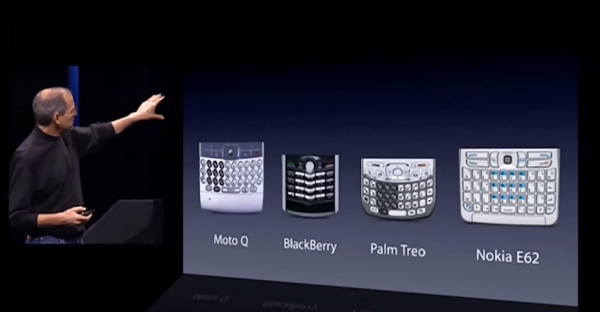
The computer industry started with hardware, and then was propelled by software. Now, the first wave of digital is the norm, and we’re going back to the origins. We are at a point where the circle is closing: from hardware to software and back.
Apple iPhone, Microsoft Surface, Google Nest, Samsung Gear, Android Wear, Microsoft Xbox, Sony Playstation, Nintendo Wii, Jawbone Up, Nike Plus: the list of devices that integrate software and hardware in a single package is growing bigger and bigger. While of course there’s and there still will be market for software-only and hardware-only companies, we are now at a point where – without a paradigm shift – innovation requires both.
Doing that isn’t easy. Nokia, king of hardware, tried to create a software ecosystem and failed. Microsoft is struggling to get Surface out of the water even if it’s an excellently crafted device, and Samsung is being marginalized by the services king, Google.
It’s more accurate to say that Nokia was, at its heart, a hardware company rather than a software company—that is, its engineers were expert at building physical devices, but not the programs that make those devices work. In the end, the company profoundly underestimated the importance of software, including the apps that run on smartphones, to the experience of using a phone. Nokia’s development process was long dominated by hardware engineers; software experts were marginalized.
— James Surowiecki (2013) Where Nokia Went Wrong
While there are inherent challenges and difficult transformations to shift a company to one side to an integrated approach, one interesting aspect is about the rhythm of change of the product itself.
The key understanding here is something almost obvious, but that is the foundation of why the software took over the world, and it’s represented by this single screenshot from Steve Job’s first iPhone presentation.

Hardware can’t be easily changed, but software can.
That’s why smartphones, and touchscreen devices like them are getting the balance perfectly right: they pushed the hardware right on the line before software becomes ideal. The full screen is software, but the rest is hardware and they blend together almost magically (turning the device turns the screen, for example).
The rules governing hardware and software are inherently different, both in terms of the production chain itself (hardware updated twice per day? unlikely, it would be annoying even with 3D printers) and the ecosystem (the developer ecosystem is key in software).
This is something I touched in first person when I worked with WideTag, a green, internet of things startup pioneering an architecture for massive data sensor collection. I wasn’t surprised when I discovered that one of its co-founders, Leandro Agrò, had a very similar approach in mind on how to blend physical and digital, hardware and software.
Step One
The hardware must be a long-term platform for the software. This means that the hardware should be as consistent as possible across the various devices and stay in place enough to give trust to the developers that it’s going to stay, to be supported and last long enough to make their development effort pay off.
I’ve worked with many companies that failed to achieve platform status exactly because they didn’t have long term vision. One of the many examples of this is Vodafone 360. The project started too big. It didn’t give any assurance of long-term reliability. It gave little edge over competitor’s features. And kept changing scope every time a short-term objective failed.
Compare that to every existing platform out there. They started with simple APIs. They gave a distinct, unique and valuable boost to developers. They lasted years. This doesn’t even need scale to happen: I’m seeing this even with a project as small as Baker Framework. Trust is essential.
Step Two
Create two interlocked release cycles. This means hardware and software should be aligned and sing together, by following different rhythms.
The importance of the two cycles is summarized in two points:
- It takes about three months for a software to be made obsolete by a competitor
- It takes about three years for a hardware to be obsolete enough to limit the software running on it
How does that sound? Strange? Too long? Horace Dediu published a quick data point about the iPhone:
iPhone 4 will probably have a market lifespan of 3.25 years.
Same as the iPhone 3GS.
The three years cycle is already here. About software, we can argue that iOS has a 1 year release cycle. That’s correct. But iOS isn’t just any software, is an operating system that is leveraging an entire App Store. In pure terms of release cycles, the App Store give operating systems the edge to stay up-to-date for the users even with a longer timeframe. The limitation is there to make hardware and software synchronized and updates in chunks are more manageable for the developers ecosystem. There’s however no physical limitation for that. If it was possible, they could update the software every time they want.
We already have good examples of that, Google Chrome being the king of that. With its lightweight background update system you don’t even know it gets updated (almost).
Keep in mind the limiting factors of each of the two parts. That the main problem about software is the incredibly fast race to make it up-to-date and new, so it’s likely that the competition comes form outside. On the hardware side instead the limit is from the software that is expected to run on it, thus you need to make hardware that can run software for a long time (many Android vendors clearly fail this). These limits are directly tied to the user perception of the device to be up-to-date:
- If my device doesn’t get updates, I’m not happy.
- If my device doesn’t run the new update, I’m not happy.
In an ideal world we would update everything all the time on devices that last forever. Since this is not possible due to the two limits above, we need to put in place the two synchronized cycles.
The Model
This brings us to the Three Years / Three Months Model of Integrated Consumer Innovation: the starting point of a physical-digital, hardware-software integrated company is to think in terms of 3y3m: aim to update your software every three months, update your hardware every three years.
Three months might sound too short, but it all depends on what you’re doing. If you’re developing something like Facebook, it’s too long. This is true also if you’re building your own startup. If you’re building an operatings sytems, maybe it’s too short, better however make it modular so users can renew it with applications quickly. Three months is the average point between the two extremes.
Three years might sound too long, but it’s the kind of long term vision you should have with hardware, because yes, while you might release a new model every year your hardware should be there for the user at least for three years to fulfill its promise.
As mentioned before, this model is already happening in the industry, and the timings can vary, but not by much. For example Americans change their cell phone every 21.7 months, or about 2 years, mostly due to subsidies. The average is 48.7 months, or about 4 years (2010 data), including countries like India and Brasil.
Three years is not just a promise to the user the device will not be obsolete soon. Three years is also a promise to the developers’ ecosystem that you are going to create around the hardware. Of course, not every hardware is meant to create an ecosystem and even less a developers’ ecosystem, but many could, and even more it also create the potential for the users to start building over it, monetize it and live with it.
From a marketing perspective, all of this creates a solid brand promise. It doesn’t break user expectations. The Galaxy S, the Galaxy Note, the iPhone, the Nexus, these are all platforms that are lasting years, way beyond any individual hardware, and consumers have both a high brand recognition and a good trust in what to expect from these objects, even if it’s a future model.
It’s not by chance that the names above are both the best devices/platforms out there and the best examples of the 3y3m model. All the companies that are getting this right have this model, even if it’s of course adapted to their own processes and needs. Sometimes it’s 6 months, sometimes it’s 4 years. But understanding and aligning the company processes and company strategy to these two speeds is what works today.
Working in the 3y3m model is also more sustainable. While there’s a trend in make consumers to consume more, there’s also a trend in having users happy with what they bought for more years. The change between ‘consumers’ and ‘users’ isn’t casual. Technology evolves fast, so we can’t likely say that a digital device should last 5 ore 10 years, but three is exactly that sweet spot today.
If you see, this is also an easy way to predict failure: carriers are forcing device changes without putting any care in either hardware or software. They put some of their own software in the phones they brand, and it never gets updated – there’s zero value in that. At the same time, they push to change your hardware as quickly as possible. Both of them fight against the users desire, and that’s why companies like Apple and Samsung that are building long-term hardware with short-term software updats win easily. All the others, aren’t doing this.
So, what company do you like to be?